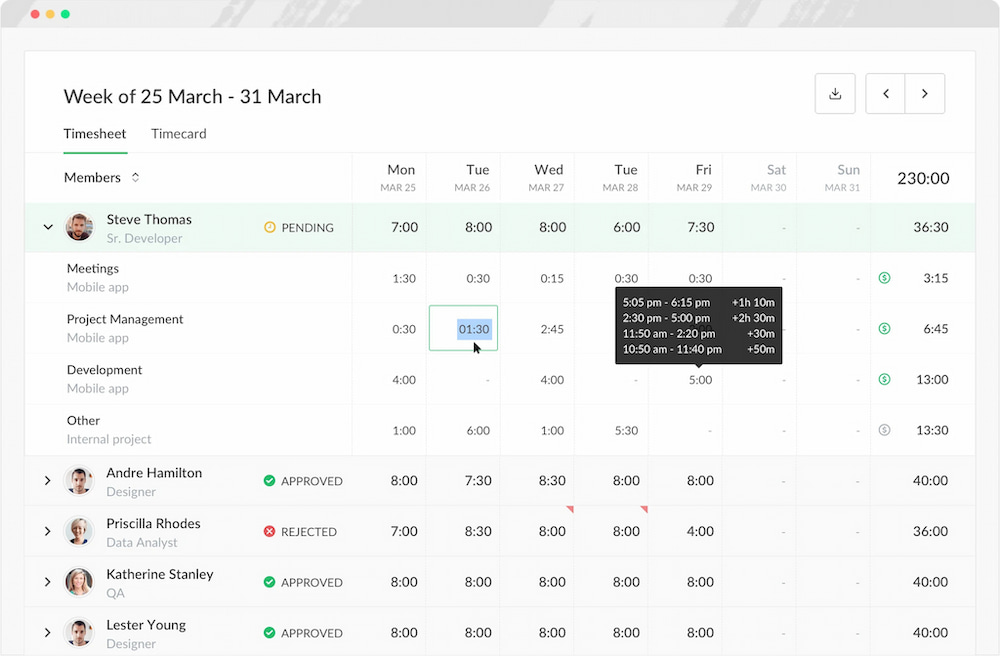Time tracking can boost transparency, productivity, and fairness—but only if it’s rolled out the right way. Too often, teams see it as micromanagement or just another tool to worry about. This guide covers how to introduce time tracking software without scaring your team. With the right approach and a time tracker like Everhour, tracking time becomes easy, human, and part of how your team already works.
🤔 Why Teams Resist Time Tracking (And What You Can Do About It)
Knowing your team’s concerns early helps you handle them better. Most resistance comes from poor past experiences or confusion. Here’s how to respond “why use a time tracker” and tackle the top objections:
| 🗣️ Objection | 💬 What it really means | 🧠 Your response | 🛠️ How Everhour helps |
|---|---|---|---|
| “You don’t trust us” | Fear of being watched | Frame tracking as team awareness, not employee surveillance | Offers employee-owned time tracking and privacy controls |
| “It’ll waste time” | Concern about extra admin | Highlight how tools like Everhour integrate directly with PM tools | Seamless task-based tracking inside tools like Asana, Trello |
| “It’ll be used against us” | Anxiety around punishment | Reassure that data will be used for fairness and planning | Transparent, non-punitive data dashboards |
| “We’re not robots” | Pushback against rigidity | Emphasize flexibility and the human element | Supports flexible tracking: manual, timer, calendar-based |
🧠 Strategies for a Thoughtful Rollout
Rolling out time tracking works best when leaders are transparent about purpose and provide tools that empower, not micromanage. Below are key strategies to make the transition smooth and successful:
⭐ 1. Lead with purpose
Start by clearly explaining why you’re introducing time tracking. Frame it as a tool for clarity and balance—not control.
💬 “We’re rolling out time tracking so we can understand where our energy goes and how to better scope projects. This isn’t about watching anyone—it’s about working smarter and avoiding burnout.”
🛠️ 2. Choose a team-centric tool
Not every tracker fits your culture. Choose one that:
- Respects autonomy
- Integrates with your existing tools
- Doesn’t break focus
Everhour does just that—seamlessly connecting with Asana, Trello, ClickUp, and more.
🚀 3. Start small, scale fast
Ease your team in with a phased approach:
- 🧪 Pilot with a small group or leadership
- 📢 Share wins and quick feedback
- 🔁 Adjust based on input before full rollout
💡 4. Focus on benefits, not surveillance
Show time tracking use cases and how it helps everyone, not just management:
- 🌱 Prevent burnout and overload
- 🔍 Spot workflow gaps and save time
- 🏆 Use data to support recognition and promotions
- 💼 Streamline approvals and client billing
⚠️ 5. Avoid common pitfalls
Don’t let good intent get lost in poor execution, ❌ don’t:
- Use tracking to punish or rank
- Skip the “why” conversation
- Leave training as an afterthought
🔍 Use Cases Where Time Tracking Brings Instant Value
| 🔍 Use case | ✨ Benefits with Everhour |
|---|---|
| Client billing | Tracks billable time, automates invoices |
| Project budgeting | Monitors budgets vs. actual time in real time |
| Team productivity | Identifies workload imbalances without micromanagement |
| Payroll | Syncs time to payroll platforms like Gusto or QuickBooks |
| Reporting | Custom dashboards for internal or external reporting |
🗣 What Real Teams Are Saying
“Took a few days to get used to [Everhour]. Very easy to integrate and helps so much with time tracking. Integrates seemlessly with Asana. Creates absolute rransparency on where staff are spending their time. Very useful tool as a leader of our organization. I really appreciate the daily, weekly, and monthly reports automatically sent to me.” [Kaden H., Capterra]
“I am the owner of the company, and I use Everhour to track time for myself and my subcontractors. All team members use the system — from web developers to tech support to project management to design.” [Jennifer, Trust Radius]
“We currently use Everhour to track the time we spend on every task. This helps us gain insights on our work. We also use it to track time in support packages that we offer to our clients. It’s also useful to establish the various task margin and to track expenses. We plan to use it also to automate the creation of invoices.” [Massimo, Trust Radius]
🎯 How Everhour Helps You Track Without Fear
Everhour isn’t a top-down control panel. It greatly helps track employee time. It’s a collaborative tool that:
- Tracks time via timers, manual entries, or task-based logs
- Keeps data visual and accessible with real-time dashboards
- Offers clear permission levels for visibility and privacy
- Supports time off, break tracking, and even shift scheduling
- Integrates with PM tools, calendars, and accounting platforms

From employees to finance teams, everyone benefits.
🧭 Sample Team Rollout Plan
| 📅 Week | 🧭 Rollout stage |
|---|---|
| Week 1 | Pilot group starts tracking time; gather feedback |
| Week 2 | Share early wins; refine training materials |
| Week 3 | Host all-hands training; address objections |
| Week 4 | Roll out company-wide; start regular reporting |
| Week 5+ | Adjust based on team feedback; optimize setup |
💬 FAQs: How to Introduce Time Tracking Software Without Scaring Your Team
Will this feel like micromanagement?
Only if it’s presented that way. With Everhour, tracking stays in the background and is owned by the employee, not a manager constantly reviewing.
Do we have to use timers?
No. Manual entries, calendar imports, and pre-filled tasks make it easy for all work styles.
Is our data private?
Everhour offers fine-tuned permission settings so teams can control what’s visible and to whom.
How will this help our team?
You’ll gain visibility into planning gaps, avoid budget overruns, and make more equitable decisions based on real effort—not assumptions.
How much time does it take to get started?
Most teams can set up and begin tracking within a day. Integrations with popular tools make onboarding painless.
What if my team is remote or hybrid?
Everhour supports distributed teams with flexible tracking options and cloud-based dashboards accessible from anywhere.
Learn how time tracking can help your strategic growth and reduce your costs!
📌 Final Thoughts: Trust + Tools = Transparency
Time tracking doesn’t need to be scary. When implemented with purpose, it becomes a pathway to better collaboration, planning, and even morale.
Everhour helps you build that pathway. With seamless integrations, customizable reports, and a human-first design, it turns time tracking into a trusted asset, not a burden.
Discover the real difference in time tracking vs objectives—and how combining both can boost team clarity, performance, and results.
👉 Discover how to implement time tracking without the revolt—boost transparency, protect team trust, and get better results without the pushback.
Wondering if time tracking is micromanagement? Learn how it can build trust—not control—when done right.
![how to introduce time tracking software without scaring your team [2025]](https://blog-cdn.everhour.com/blog/wp-content/uploads/2025/07/cherrydeck-D5bISElmYZQ-unsplash.jpg)
